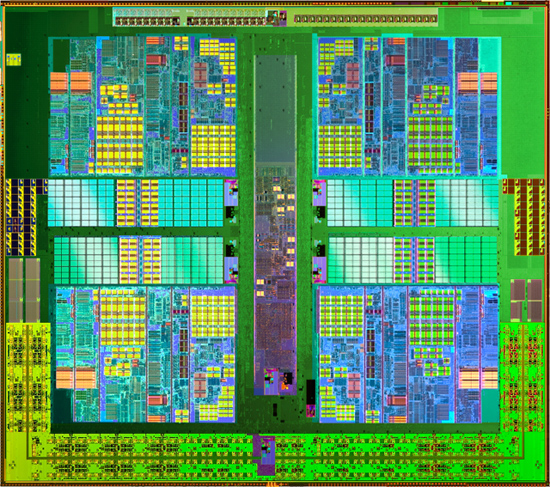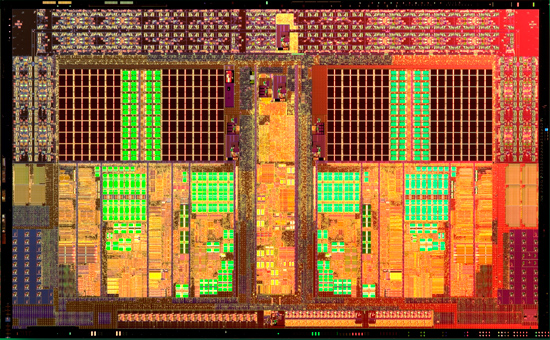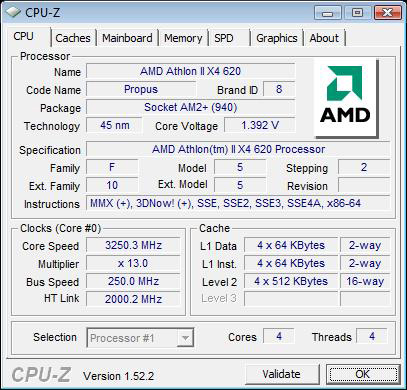AMD Athlon II X4 620 & 630: The First $99 Quad Core CPU
by Anand Lal Shimpi on September 16, 2009 12:00 AM EST- Posted in
- CPUs
How does AMD respond to Lynnfield? Is it by drastically cutting prices on Phenom II? Nope. By introducing the world’s first quad-core processor to debut at $99. Now that’s cool.

It’s called the Athlon II X4 and its existence shouldn’t be any surprise. AMD quietly announced it along with the Athlon II X2 line.

Today we get two models: the Athlon II X4 630 and the Athlon II X4 620, priced at $122 and $99 respectively. The only difference between the two is clock speed; the 630 runs at 2.8GHz while the 620 runs at 2.6GHz. These are both AM3 chips meaning they'll work in AM3 motherboards with DDR3 memory or AM2+ boards with DDR2 memory.
| Processor | Clock Speed | L2 Cache | L3 Cache | TDP | Price |
| AMD Phenom II X4 965 BE | 3.4GHz | 2MB | 6MB | 140W | $245 |
| AMD Phenom II X4 955 BE | 3.2GHz | 2MB | 6MB | 125W | $245 |
| AMD Phenom II X4 945 | 3.0GHz | 2MB | 6MB | 125W | $225 |
| AMD Phenom II X3 720 BE | 2.8GHz | 1.5MB | 6MB | 95W | $145 |
| AMD Phenom II X2 550 BE | 3.1GHz | 1MB | 6MB | 80W | $105 |
| AMD Athlon II X4 630 | 2.8GHz | 2MB | 0MB | 95W | $122 |
| AMD Athlon II X4 620 | 2.6GHz | 2MB | 0MB | 95W | $99 |
| AMD Athlon II X2 250 | 3.0GHz | 2MB | 0MB | 65W | $87 |

This isn’t a harvested Phenom II nor is it a pair of Athlon II X2s, instead it looks like we have a brand new die on our hands (some Athlon II X4s will be crippled Phenom IIs but AMD insists that the new die will be used). The Athlon II X4 has four cores on a single die, but unlike the Athlon II X2 each core only has a 512KB L2 per core. You can tell by the die shot that the core-to-cache ratio is much higher than on the X2:

The 45nm Athlon II X4 Propus die

The 45nm Athlon II X2 die (note the larger L2 per core)
Like the rest of the Athlon II lineup there is no L3 cache. This helps keep the die small (and affordable) but also hurts performance:
| Processor | SYSMark 2007 Overall | E-Learning | Video Creation | Productivity | 3D |
| AMD Phenom II X4 920 (2.8GHz) | 173 | 151 | 212 | 167 | 167 |
| AMD Athlon II X4 630 (2.8GHz) | 157 | 128 | 221 | 131 | 162 |
| % of Phenom II X4 | 91% | 85% | 104% | 78% | 97% |
At the same clock speed the Athlon II X4 should offer roughly 90% of the performance of a Phenom II X4.
| Processor | Cores | Manufacturing Process | L1 Cache | L2 Cache | L3 Cache | Die Size | Transistor Count |
| AMD Phenom II X4 | 4 | 45nm | 128KB per core | 512KB per core | 6MB | 258 mm2 | 758M |
| AMD Athlon II X4 | 4 | 45nm | 128KB per core | 512KB per core | 0MB | 169 mm2 | 300M |
| AMD Athlon II X2 | 2 | 45nm | 128KB per core | 1MB per core | 0MB | 117 mm2 | 234M |
| Intel Core 2 Quad Q8xxx | 4 | 45nm | 64KB per core | 4MB | 0MB | 164 mm2 | 456M |
The price is unbeatable. If we ignore the 630 for a moment, the Athlon II X4 620 is by far the cheapest route to four cores on the market. Intel’s most affordable quad-core is the Core 2 Quad Q8200 at $163, while AMD would previously charge you $163 for a Phenom X4 9600B. This is where the AM3/AM2+ compatibility play really helps out. Motherboard/memory costs are as cheap as possible thanks to AMD's incredible socket flexibility.

And just in case you’re wondering, yes, the Athlon II X4 620 actually delivers performance competitive with the Q8200 but for 60% of the cost. It’s not all that clear cut, there are some cases where the 620 is faster but others where the Q8200 is much faster. On average it ends up being a wash but you’ll want to pay attention to the coming pages to see how the cookie crumbles as it does vary from test to test.

Codename Propus
Overclocking isn't unfortunately as good as the Phenom IIs; the result of a conscious design decision or simply the early nature of the Propus die. That being said, without a single extra millivolt I was able to hit 3.25GHz on my Athlon II X4 620 sample - making it even more valuable. Extra voltage proved mostly useless, I could only approach 3.4GHz with an extra 300mV.
Let’s see, have I thoroughly ruined the surprise? Check. Now let’s get to the tests.
The Test
| Motherboard: | Intel DX58SO (Intel X58) Intel DX48BT2 (Intel X48) Gigabyte GA-MA790FX-UD5P (AMD 790FX) |
| Chipset: | Intel X48 Intel X58 AMD 790FX |
| Chipset Drivers: | Intel 9.1.1.1015 (Intel) AMD Catalyst 8.12 |
| Hard Disk: | Intel X25-M SSD (80GB) |
| Memory: | Qimonda DDR3-1066 4 x 1GB (7-7-7-20) Corsair DDR3-1333 4 x 1GB (7-7-7-20) Patriot Viper DDR3-1333 2 x 2GB (7-7-7-20) |
| Video Card: | eVGA GeForce GTX 280 |
| Video Drivers: | NVIDIA ForceWare 180.43 (Vista64) NVIDIA ForceWare 178.24 (Vista32) |
| Desktop Resolution: | 1920 x 1200 |
| OS: | Windows Vista Ultimate 32-bit (for SYSMark) Windows Vista Ultimate 64-bit |










150 Comments
View All Comments
Genx87 - Monday, September 21, 2009 - link
This losing battle for AMD has been going on since the introduction of the Core 2 Duo years ago. Where have you been?mdk77777 - Wednesday, September 16, 2009 - link
945 has been at $170 for weeks. That's a $55 difference from the price listed by ANAND :!: , it is also available at 95 watt :!:955 has been at or below $200
But that would conflict with the second coming of I5 at $210 so he conveniently ignores current pricing. :mrgreen:
Talk about bias, you write an article about pricing and market position and then ignore current pricing and market positions.
Pretty amazing.
Voo - Wednesday, September 16, 2009 - link
You do understand what the listed prices are, and just want to flame, right?mdk77777 - Wednesday, September 16, 2009 - link
How does AMD respond to Lynnfield? Is it by drastically cutting prices on Phenom II? Nope.Thats how the article starts. Correct, but they lowered prices weeks ago in anticipation.
A list price means nothing if it has been widely, significantly, and uniformly discounted.
Obviously they will update. Again, a story about market prices and market value of various CPU should reflect the market pricing.
yacoub - Wednesday, September 16, 2009 - link
you are correct that the actual prices are what matters -- after all, the entire point of this (and most if not all) article(s) here are for the benefit of people considering a purchase.Lolimaster - Thursday, September 17, 2009 - link
And then they talk about anand not being biased...PII 955 $189
PII 945 $169
Hey even in my country (Peru) wich has a lot of tech taxes the 955 costs less than AMD "official" price.
silverblue - Thursday, September 17, 2009 - link
Depending on which sites someone uses, they may not offer a better deal than another site they may be unaware of, likewise they could get a CPU for cheaper than you or I can. It's strictly relative in the end and doubtful to be the result of some sort of bias. Anand seems very impressed with the Propus and so too will be a lot of other people.Looking more closely at it, I believe it should perform closely with a similarly clocked (or overclocked?) Phenom I due to the lack of an L3 cache, though I couldn't say which would perform faster. Incidentally, I've been checking dabs.com and their most popular CPU is the Phenom X4 9650 at about £80; this is only 2.3GHz and is more expensive than the newly-launched Athlon II X4 620 by about £5, so it stands to reason that people will go for this one instead soon enough.
What I would really like to see, however, is a direct comparison between the 620 and the PII X4 905e (2.5GHz, 6MB L3) - it should be relatively simple to overclock one/downclock the other and see how much the lack of an L3 cache hurts the Athlon in a head-to-head, why the Athlon II X4's TDP is 95W whereas the 905e (with the 6MB L3 cache, remember) has a TDP of 65W, and whether it's worth the extra £50 for the 905e.
I did look at other CPU prices on this site as well as on a couple of others. The PII X4 955 and the i5-750 are roughly the same at about £150-£155 (though dabs.com has the 955 as £165 for some daft reason), whereas the PII X4 965 is closer to £180. It's very important to look around for the best price, however I'm starting to doubt the reason for the 965's existence now, at least until they cut its price.
mapesdhs - Thursday, September 17, 2009 - link
Indeed, shopping around is essential, and watchout for shipping
charges aswell.
After deciding what to buy, I Google for the part numbers or names
of the items I want, gather a selection of sites, see what can be
saved re shipping costs by buying multiple items from one seller.
I've ended up using a variety of companies over the years, sometimes
well known (Dabs, Scan, Microdirect), sometimes more obscure (Komplett,
C&C Central, Lambdatek, Overclockers, Tekheads). And doing it this
way means one has a better chance of locating special offers. I also
check on eBay for BIN offers from reputable sellers, which in one
case resulted in the best price for a PSU I wanted. The company names
above are in the UK, but the same applies anywhere.
Ian.
East17 - Thursday, September 17, 2009 - link
1. A benchmark should test the architecture clock for clock. Dynamic overclocking just messes things up even if it's on by default.Sure Turbo is a nice addition and sure it should have been available ever since dual core CPUs appeared just to prove customers that you're doing something about single thread performance too.
Turbo is a feature, not an architectural advantage. It's like saying a mainboard with Quad GigabutLAN on P45 is more performant than a Dual LAN on X58 just because it has this feature of having four LAN ports. Sure, if you do a LAN performance test you could find many ways in which you could show that the mainboard with Quad LAN is faster but surely you couldn't argue that P45 is superior to X58.
Anyway ... the testing shoul have been done with Turbo on and Turbo off to clearly show thr difference .
2.Deneb is 252% of Propus (300mln -> 758 transistors) but only offers around 10% performance improvement... Could you justify making the die size so much bigger just for 10%? Besides, if we talk about profit, if 252% = 225$ (Phenom 3GHz) and 100% = 99$ (Athlon II X4) ... Propus seems more profitable .
carniver - Wednesday, September 16, 2009 - link
Athlon: Emergency Edition